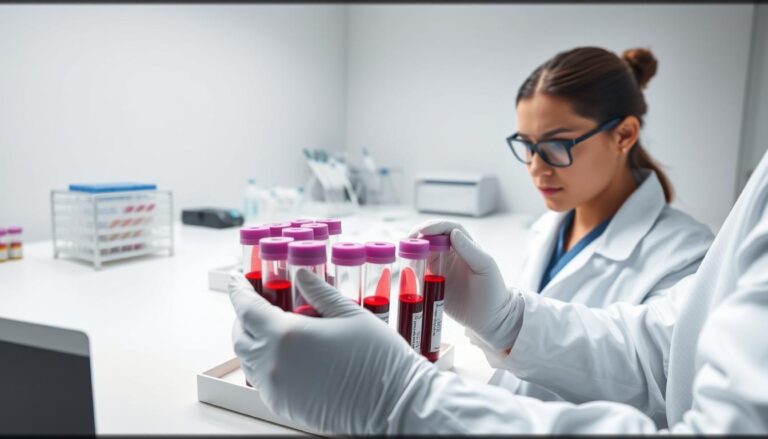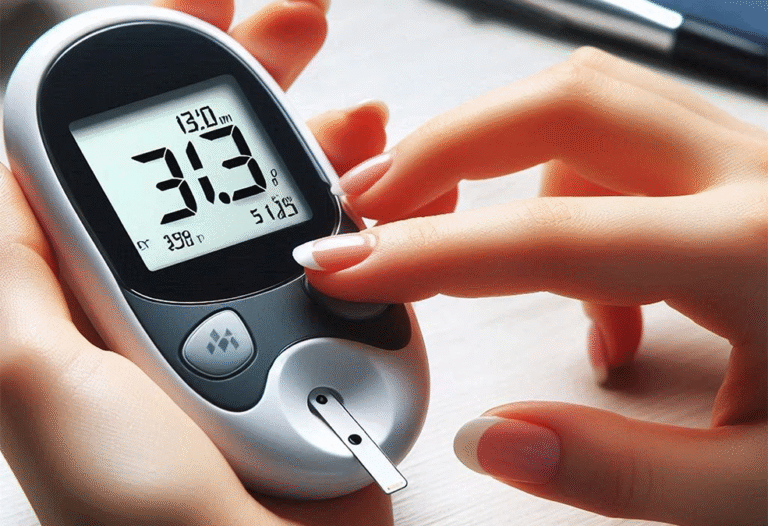Home Blood Testing vs. Laboratory Testing: Pros and Cons
In today’s healthcare world, we have more ways to get blood tests done. At-home blood testing kits let people collect their own samples at home. But how do these methods compare? Which one is best for you? Let’s look at the good and bad of home vs. lab blood testing.

More people want healthcare that’s easy, accessible, and controlled by them. Home blood tests are becoming a popular choice. The global market for at-home testing kits is growing fast. But what should you think about when picking between home and lab tests?
Understanding Modern Blood Testing Options
Blood testing has changed a lot in healthcare. No longer do we need to go to the lab for tests. Now, we have many ways to test our blood, from at-home kits to lab tests with blood test abbreviations, giving us more control over our health.
Types of Home Testing Methods Available
Home blood testing kits are now popular. They let you take a small blood sample at home. You can then send it to a lab for detailed tests. Other options include dried blood spot analysis and urine tests.
Laboratory Testing Process Overview
For those who want a professional touch, traditional lab tests are still good. A phlebotomist takes blood from your vein. The blood then goes to a lab for detailed analysis.
Current Market Availability and Costs
The blood testing market has grown a lot. Companies like Everlywell and HealthLabs offer many tests. Prices range from $49.99 to $939, depending on the test.
Choosing between at-home tests and lab tests depends on your needs. Knowing the options and costs helps you make the best choice for your health.
| Test Type | Sample Collection | Processing Location | Average Cost |
|---|---|---|---|
| At-Home Blood Test Kit | Fingerprick, Dried Blood Spot, or Urine | Home or Laboratory | $49.99 – $200 |
| Laboratory Blood Test | Venipuncture | Laboratory | $28 – $939 |
Home vs Lab Blood Testing: Accuracy and Reliability Comparison
At-home blood test kits have become more popular for healthcare. But, there’s debate about their accuracy compared to lab tests. Studies show mixed results on how well home tests match professional lab tests.
Some studies say only a few home tests are reliable. This means home tests might not always be accurate. But, other research shows most people can get good results from home tests. These results often match what lab tests find.
Many things can affect how accurate home tests are. This includes the testing method, how well the user follows instructions, and how the sample is handled. Lab tests are usually more accurate because they follow strict procedures and are checked by experts.
It’s important to understand the differences in accuracy and reliability for fingerstick tests, in-home phlebotomy, and direct-to-consumer lab tests. Knowing the pros and cons, along with a list of blood tests with abbreviations, helps people choose what’s best for their health needs and preferences.
Key Benefits and Limitations of Each Testing Method
Home blood testing and lab testing have their own ups and downs. Knowing these can help you choose the right method for your needs.
Advantages of Home Blood Testing
- Convenience: Home kits let you test at home, skipping the trip to the doctor.
- Privacy: Home testing keeps your health concerns private, which many prefer.
- Early detection: Home tests might catch diseases sooner since you test more often.
- Accessibility: It’s great for those who can’t easily get to a doctor or live far from healthcare.
Benefits of Laboratory Testing
Labs also have their own perks:
- More tests: Labs offer a wider range of tests for a fuller health check.
- Proper sample collection: A trained pro collects your sample, reducing mistakes.
- Quick results: You get your results fast and can talk them over with a doctor right away.
Privacy and Convenience Factors
Privacy matters a lot when picking between home and lab tests. Home tests are more private since they’re done without a doctor. But, lab tests mean you get your results explained by a pro right away. The cost can differ based on the test and your situation.
| Factor | Home Blood Testing | Laboratory Testing |
|---|---|---|
| Privacy | High | Moderate |
| Convenience | High | Moderate |
| Cost-Effectiveness | Varies | Varies |
Conclusion
Home and laboratory blood testing each have their own strengths and weaknesses. Home testing makes it easier to get tests done and can catch diseases early. But, there are worries about the accuracy of these tests without a doctor’s review.
Lab testing, however, is still the top choice for most medical diagnoses. It offers detailed and trustworthy analysis. As rules change and tech gets better, the difference between home and lab tests might get smaller.
The choice between home and lab tests depends on what you need and the test you’re taking. It’s about finding the right balance between ease and the certainty of lab results. Knowing the good and bad of each helps people make better health choices.
As we want healthcare that’s easy to get and tailored to us, home and lab tests will keep getting better. This will give us more choices that are private and convenient but still top-notch. By moving forward in this way, we can help people take care of their health better, with the right tools and the help of doctors.







